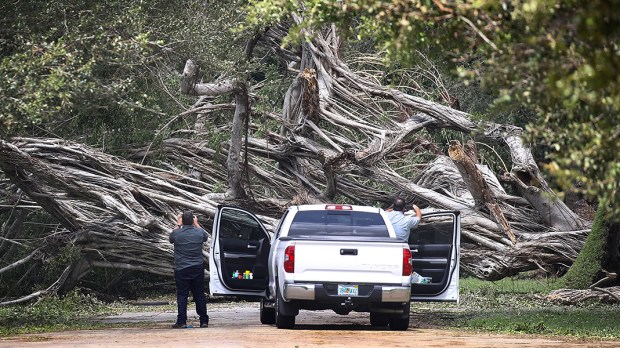“Massive destruction and devastation” is how one resident of the U.S. Virgin Islands describes the scene outside his home in the wake of Hurricane Irma.
“There’s not a leaf left on the trees, and all the trees are down and twisted,” said Steven Olive, a distributor of tourism-related products who lives in St. Thomas in the Virgin Islands.
Olive reported that the local hospital is “completely ruined” and that a lot of patients had to be transferred to St. Croix in the Virgin Islands, Puerto Rico and even to other parts in the U.S. Some grocery stores are operational, but gas lines are “like from here to kingdom come,” he said. There is an overnight curfew, but there is looting, which prompts residents to bring their generators indoors when they can’t watch them.
The record-breaking storm, which ripped through the Caribbean mostly as a Category 5 hurricane, claimed 27 lives across the region. It then made landfall in southwest Florida on Sunday, and by Monday afternoon, the death toll throughout Florida stood at 4. About 6 million people in the state were without power, as Irma, now a tropical storm with winds around 60 mph, headed into Georgia.
“We’re getting a lot of aid from FEMA,” Olive said Monday morning. “There’s a temporary military base in St. Croix, and Navy ships are there and they’re transporting a lot of stuff over by C-130s. So we’re getting a lot of aid.” But he said that after cleanup, the Virgin Islands will basically have to rebuild “from scratch.”
Olive’s own house was spared of any significant damage from the high wind and pounding rain, and his wife and family, who rode out the storm with him in the house, are fine. But the experience “was rough,” he said.
“That wind coming through here, the rain was like bullets,” Olive said. “You couldn’t go outside—you’d be blown away—but when we opened that door [after the storm] we couldn’t believe what we saw.”
He added that it was better to experience the storm during the day, when “at least you can see” what was happening outside. “If it’s at night you don’t know what’s going on outside,” he said.
At first, St. Thomas got blasted by the south wall of the eye of the hurricane. Later, when the area got hit with the tail end of the storm, it brought very high winds, and Olive’s family could look out a window and see “things flying by.”
“I told my family we have to sit down and start praying,” he said. “It was really bad.”
Olive said it’s sad to see “so many people suffering, hanging out their cloths to dry” and removing water-logged items from their homes.
“I was talking to some kids yesterday, and they were asking me, ‘When is the internet coming back?’ I said, ‘Listen, you’re going to have to start learning those games that kids used to play, like marbles and jacks and flying kites.'”
In Florida, many people were trying to get an update on their hometowns while staying in places where they had evacuated. Patrick Novecosky, president of Nova Media, was watching the storm for several days and was set to stay in his three-year-old house in Ave Maria, Fla., built to Category 4 hurricane building codes.
“As it started hitting the Caribbean we saw the damage that it did, and they said it was the largest Atlantic storm in history,” said Novecosky. “As it was growing into a Category 5, the models were showing that it was going to hit Miami and Ft. Lauderdale, but early Thursday it shifted West, and Ave Maria was in the bullseye. … With five children between the ages of 3-14, we decided it was better to be safe than sorry. We were confident our home would withstand it, but we just didn’t want to deal with the aftermath, the flooding, and being without electricity for weeks.”
The family drove to the Florida panhandle to stay with friends and are staying in touch with friends back home to know when electricity will be restored.
Also leaving home was Gail J. Coniglio, who lives about an hour east of Naples in Davie, Fla. Coniglio, owner of Gail Jean Marketing & Media, has lived through many storms over the course of 30 years in Florida. But since she has a daughter with type 1 diabetes, it was a safer decision to go someplace less likely to lose power. She and her family drove to stay with friends who live south of Atlanta, Ga. The normally 10-hour drive took 24 hours.
In Key West, damage appeared to be far less than what had been anticipated. The Washington Post reported that the fierce gael persisted for hours on Sunday morning, and the area experienced flooding, power outage, downed trees, but nothing catastrophic.
“The general sense is that we lucked out and it’s not nearly as bad as everyone predicted,” said Scott Unger, a freelancer for The Post.
The Miami Herald reported that damage appeared to be far worse on islands to the east, near where Irma made landfall and its eyewall carried destructive force.
Key West has never experienced the full force of a hurricane since the 1922 dedication of Our Lady of Lourdes Shrine, on the grounds of the Basilica of St. Mary Star of the Sea.
Ida Roberts, director of religious education at the parish, left the area last week for Orlando and cannot get back because of interruptions in the highway that connects the keys. But she said Monday that her son in Key West told her there is “little or no damage.”

